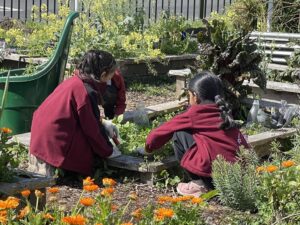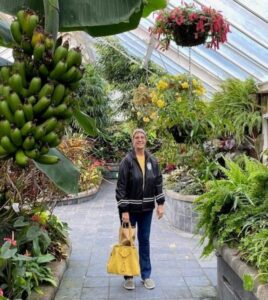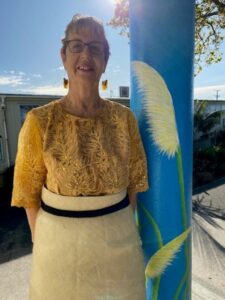Diana interrupted her busy retirement recently to talk to us about her time as Principal in two Tāmaki Makaurau Enviroschools, sharing her Enviroschools story and what she has learnt along the way. Here is what she told us.
The start of the journey
I had a friend, Shirley Dephoff, who was one of the original Enviroschools facilitators and she discussed the programme with me. It interested me and I thought it could be valuable for the school I was at, Ōwairaka District School (ODS), to be involved in. I invited Shirley along to the school to speak to the staff. It was clear there was a lot of work to do, shifting the culture towards one of care, but it did give us a focus.
There were a few lovely trees around in the grounds at ODS. A pōhutukawa in particular had been in the school for a long time but the rest of the environment was mainly grass, concrete and buildings with one or two traditional gardens around. Unfortunately, there were call outs from police and regular break ins and cleanups necessary after weekends.
Slowly I noticed that, as we got support for kai gardens, there was a behaviour change with a level of pride and protection developing towards the school grounds. We saw less damage and more whānau engagement. We began holding a Green Day once a term when everyone would go out to tidy up – a real focus that they loved. There was a sense of responsibility – that it’s their school to look after. This has continued for over 10 years.
An emerging programme
Environmental programmes weren’t a focus in the early 2000’s. ODS was in a time of change with behaviour management being an emphasis along with employing quality staff. Teaching and learning about the environment weren’t considered important to the school or the community in those days. This meant it was a bit of battle introducing a different approach. These days it is so much easier but in the early days it was on the fringe. 13 years on it was embedded and woven into the Strategic Plan and culture of the school.
Moving on

The kai gardens are places of peace and productivity.
Transitioning to another school, Papatoetoe West School (PWS) worked well for me because the board of trustees of the school I was moving to came and visited me at my old school and liked what they saw and were interested and supportive of Enviroschools from the beginning. That meant key people, including the Deputy Principal, were on board. The new school felt like a blank canvas, and I was ready for this move and challenge.
The Deputy Principal wanted to develop the kai gardens and include Garden to Table but there was some resistance from existing staff. There was however energy and expertise offered from the community, from others sharing the kai garden vision. Some of the local churches came and volunteered and there were working bees to lay brick pathways. People were coming in and making offers, then would actually follow up.
Initially there was a small crew on staff, then Cate Jessep (Enviroschools facilitator) initiated whole school staff meetings. Her experience and lovely manner helped shift staff to see the benefits and ways to achieve these, starting with a whole school waste focus. This also helped to turn around the look of the environment.
An integrated approach
Enviroschools is now more integrated than ever at PWS, partly because it is so much more topical now to be promoting caring for the environment and also because the programme is embedded in the school strategic plan. Parents who have been surveyed are always positive and now with the latest thrust towards the local curriculum and te ao Māori and history it is even more embedded. This has included the adoption of a local park.
An example of this engagement is this year’s topic in the school. Last year’s theme was Climate Change and at the end of that year during a Parent Day there were displays in the hall and various themes were suggested for 2023. Everyone was invited to vote on the theme that would run through student learning for 2023. Kaitiakitanga became that theme and has been woven into all the work that the students have been doing for the year.
Originally, I saw EfS as an extra. It took me a while to see that all things were integrated and then be able to show others. Cate was amazing at helping make these connections.
Influence over time

Diana made the most of her visits to other countries, visiting a range of places to learn about different approaches.
Because I love Enviroschools, I have promoted it with Principals and people in other schools whenever I had the opportunity. We were a mentor school for a new neighbour school who became an Enviroschool. I contributed to cluster meetings and hosted some of these. Staff who have moved to other schools have helped spread the word. Since the forming of our Kahui Ako I believe there has been an increased influence.
During sabbaticals and at other times I have visited Enviroschools throughout New Zealand and similar schools overseas. One of my sabbaticals focused on the Environment and I was privileged to visit Green Schools and Forest Schools in Singapore, Canada and England. It was an amazing experience, and I was able to share back to colleagues. I see myself as an advocate and have been mentoring as well.
Barriers
Initially people kept saying, we can’t do this because we don’t have the money or resources – people being hung up on funding and resources. I went out and found the sponsorship and didn’t see that as a barrier. I believe there’s always a way and lots of people and companies are willing to help.
Getting staff on board has been something that I’ve really had to work hard on, and Cate has supported this.
It has been challenging to get in touch with local iwi because they are so busy. By getting Cate to help through her council contacts has now brought in this magnificent person in to help with local knowledge – an amazing person. They recently had 80 people at a cluster meeting that he spoke at and people left full of fire!
Motivation
Seeing the changes and getting feedback from students and parents is really uplifting. For example, many wrote excellent speeches with an Enviroschools focus. Seeing the whole staff come together is great too.
Being a school that people wanted to visit meant sometimes we had special visitors (including the Governor General). People were energised, running around preparing. It was lots of fun and lifted the profile of Enviroschools and the school.
And of course, having Cate come in – so positive and affirming and acting as an external voice, for both principal and staff. She comes in with extra energy and is an absolute asset to the programme. It was fantastic to have excellent support from Enviroschools facilitators. It was also great to be able to attend regular meetings of Enviroschools teachers and build up a strong network. Regular cluster meetings, tours with key teachers, NZAEE conferences and Enviroschools hui have all been good for inspiration.
Significant moments
Each Holistic Reflection has been really significant. During this time, we’ve stopped and looked back on how far we have come and thought about next steps. I feel this is a very significant part of the Enviroschools process and is so beneficial. Preparing for these really engages the staff. Getting parents involved in surveys and seeing the connections, the network, the councillors and the positive change in the school environment are all significant.
Having the kids being part decision-making is so important. We had some amazing student leaders over time. They would go off to Intermediate, taking the environmental messages with them and often returned for reflections.
Meeting with other people and visiting other schools is a real shot in the arm including the ones visited when overseas. I’ve been Inspired, made changes or been affirmed that I’m on the right track.
“What I’ve learned most from you, Diana, is how, when you have a clear idea of what you want to achieve, you focus and give it attention and time, regardless of how ambitious it is and all the while clearly articulating your vision to others. Other people get energised by your enthusiasm and inspired to get involved and contribute. The ripple soon flows out across your community, kāhui ako and network, and as you found out, staff, students, community and parents support your vision wholeheartedly and collaborate so you can get funding, support, awesome teachers, students and wonderful spaces for them to do action learning!” – Cate Jessep, Enviroschools Facilitator
Enablers
Having an effective Enviroschools facilitator is a great enabler, as is having meetings with others and visits to other schools. Part of the success comes from getting staff onboard and working together, having BoT support and including Enviroschools in the school strategic plan. Having a strong student green team is crucial.
A general increased awareness of climate change has helped legitimise the programme and increase its importance.
I personally believe in a holistic curriculum and ensuring students get a wide range of experiences. I promote inquiry/action learning. The Action Learning Cycle is really vital so that children don’t just investigate but follow through with the sort of action they can achieve. In the past teachers would come up with hypothetical things which were really not much help. Enviroschools students are involved with their own concrete actions. The Local Curriculum focus now is in alignment with Enviroschools as is the new Aotearoa NZ Histories Curriculum. Integration is clearer and easier, and we actually have to have license to do these this.
Engaging parents/ whānau
Kids are going home and sharing what they are doing and inviting parents in to school to see what’s going on. The surveys that we have done of our school community rates Enviroschools highly. This comes through continually sharing, making sure parents are aware and keeping those messages up. Invite them into the hall for celebrations of learning, get parents to comment and contribute, give them a voice. Be flexible with your timing, make it a whole day 8am – 6pm with prizes and a fun passport so that it enables and encourages everyone to participate.
Leaving a legacy for other Principals

After many years leading learning, Diana is now focusing on family and growing other interests.
I would suggest they do all of the above but do one or two bits at a time, ensuring Enviroschools is not an add on but is embedded into teaching and learning programmes and the philosophy of the school. The Guiding Principles can be developed more meaningfully through integrating the programme. So many organisations out there are supportive.
Principals need to understand that a great deal of what they currently do in schools relates to the Enviroschools Principles. I suggest they be fully involved, be part of it otherwise it is really hard. Take up opportunities to visit others, attend clusters, and Principals meetings. Share the load. Bounce ideas around with the Lead teacher and Deputy Principal – the whole of senior leadership.
Provide resources (including people resources) to support the learning and action. Share ideas of how to include Enviroschools in their school programmes. Give them the opportunity to talk to other Principals who have been on the journey.
Handover/ succession
The BoT were looking to sustain Enviroschools in the school so it was part of the interview and in the strategic plan. I ensured there was a strong environmental philosophy and key people in the school who were able to continue.
Fortuitously the incoming principal was at the Enviroschools Principals’ hui in 2022 so had a great introductory experience. Prior to coming to our school, she hadn’t been at an Enviroschool. Cate was also instrumental in helping her build an understanding of the role and the programme.
Because BoT wanted Enviroschools to continue and the staff were very much on board Enviroschools is now part of the culture of the school and the themes for the year tend to have an environmental focus. There is also a formal responsibility to the local park and caring for that, so that has to be sustained.
What now?
I have so far been able to take advantage of short courses offered through the Tauranga Libraries on foraging, identifying weeds, making kawakawa balm, healing teas and have taken grandchildren to some classes. I’m happy to support where I can, volunteering when in Auckland. I’m also mentoring the new Principal at PWS.
“What a legend you are for what you have done in two Enviroschools in 20 years. It has been a privilege working with you and seeing first-hand what a generous and inspirational Enviroschools leader/stalwart can achieve. There will be hundreds of staff and students you have already empowered to instinctively think and act sustainably under your leadership, Diana. I hope other Principals take up your offer and become as passionate Enviroschools space-creators and advocates as you are.” – Cate Jessep, Enviroschools Facilitator
Banner image: At working in the gardens at Papatoetoe West School.
Diana has offered to be a sounding board and support for anyone wanting to talk about how to integrate the Enviroschools programme.
If you would like to talk to her, please email stories@enviroschools.org.nz so that we can put you in touch.
